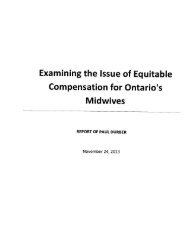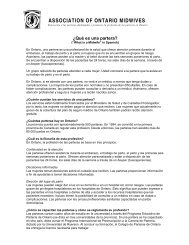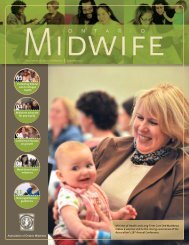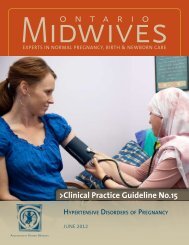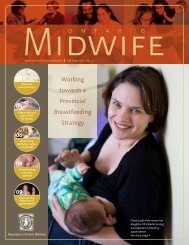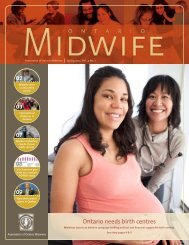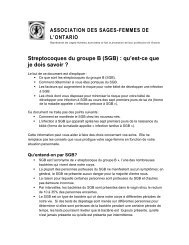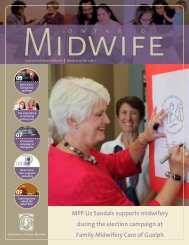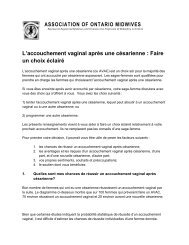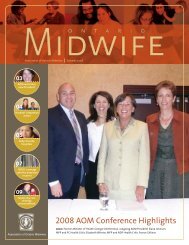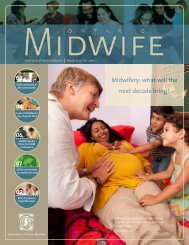Fall 2010 - Association of Ontario Midwives
Fall 2010 - Association of Ontario Midwives
Fall 2010 - Association of Ontario Midwives
You also want an ePaper? Increase the reach of your titles
YUMPU automatically turns print PDFs into web optimized ePapers that Google loves.
<strong>Midwives</strong>, nurses, physicians and hospital administrators cement positive interpr<strong>of</strong>essional relationships when working on projects such as Baby-friendly certification.<br />
Interpr<strong>of</strong>essional team leads to Baby-friendly success<br />
St. Joseph’s Healthcare Hamilton<br />
has recently had its Baby-friendly<br />
Hospital status re-designated thanks<br />
to interpr<strong>of</strong>essoinal collaboration<br />
and education. This project has led to<br />
increased communication and education<br />
between physicians, nurses, midwives<br />
and lactation consultants.<br />
Despite having first become a<br />
Baby-friendly Hospital in 2003, getting<br />
re-designated was not a walk in the<br />
park, according to<br />
Shirin Aghili, RM, head<br />
midwife at St. Joseph’s. “Being part<br />
Because many<br />
<strong>of</strong> the whole<br />
mothers coming into<br />
interpr<strong>of</strong>essional<br />
St. Joseph’s are from<br />
communities that<br />
meeting process<br />
routinely unnecessarily and being the head<br />
supplement with<br />
midwife is hugely<br />
formula at birth until<br />
eye-opening,”<br />
the breast milk comes<br />
in, it was quite easy for - Shirin Aghili, RM,<br />
rates <strong>of</strong> breastfeeding<br />
Head Midwife<br />
initiation to slip below<br />
desirable levels.<br />
In addition, St. Joseph’s<br />
nursery is in some ways working against<br />
it. Though categorized as a level one<br />
nursery, Aghili says it is capable and <strong>of</strong>ten<br />
does handle more complicated cases and<br />
infants with more serious issues who may<br />
require supplementation in the initial<br />
days due to medical issues.<br />
“There was a need for regrouping<br />
and re-teaching the hospital staff,”<br />
Aghili said with regard to getting the<br />
designation back. For example, proper<br />
documentation for babies coming into<br />
the nursery is essential to show cases<br />
where supplementation is needed, such<br />
as hyperbilirubinemia.<br />
“The hospital has implemented new<br />
forms that say the baby must be on the<br />
breast for 14 minutes while in the delivery<br />
room,” Aghili said. “Skin to skin is highly<br />
encouraged.”<br />
Patients also needed some<br />
education. For example, if<br />
patients indicate they plan<br />
to formula-feed when they<br />
register at the hospital, they<br />
are told not to be disappointed<br />
if staff ask again or promote<br />
breastfeeding.<br />
In addition to encouraging<br />
those who would normally<br />
supplement at birth until the<br />
milk comes in to breastfeed<br />
earlier on and be patient with<br />
the process, Aghili said they<br />
also recommend patients take<br />
advantage <strong>of</strong> on-call help as needed.<br />
Aghili said the process was spearheaded<br />
by a very dedicated Dr. Tamar Packer,<br />
Medical Director <strong>of</strong> Newborn Services at<br />
St. Joseph’s, but also successful thanks to<br />
a great interpr<strong>of</strong>essional environment.<br />
“The hospital is so proud they have<br />
midwives (because they) know about our<br />
good breastfeeding rates,” she said.<br />
As head midwife, Aghili sits on<br />
multidisciplinary steering committees<br />
for maternal, child and newborn health.<br />
Another midwife at her Hamilton practice<br />
sits on the regional lactation committee.<br />
The meetings provide a great avenue<br />
for discussion and troubleshooting<br />
among pr<strong>of</strong>essional colleagues who have<br />
different backgrounds and skill sets.<br />
“Being part <strong>of</strong> the whole meeting process<br />
and being the head midwife is hugely<br />
eye-opening,” she said. “It allows us, as<br />
midwives, to see what an institution<br />
has to face in order to increase the<br />
breastfeeding rates. It is so easy to<br />
just say ‘everybody breastfeed’ but to<br />
actually put it into practice and put it into<br />
education is challenging.”<br />
Another positive outcome from the<br />
process was that the hospital’s lactation<br />
consultant approached Aghili and asked<br />
if the practice would like additional<br />
breastfeeding education for its students<br />
and new registrants. Because the<br />
Hamilton <strong>Midwives</strong> takes on many<br />
students, Aghili said they now routinely<br />
send students to the breastfeeding clinic<br />
– which is available to clients through<br />
self-referral seven days a week – for<br />
additional breastfeeding education.<br />
The hospital’s Baby-friendly designation is<br />
reassessed every five years.<br />
www.aom.on.ca<br />
05



